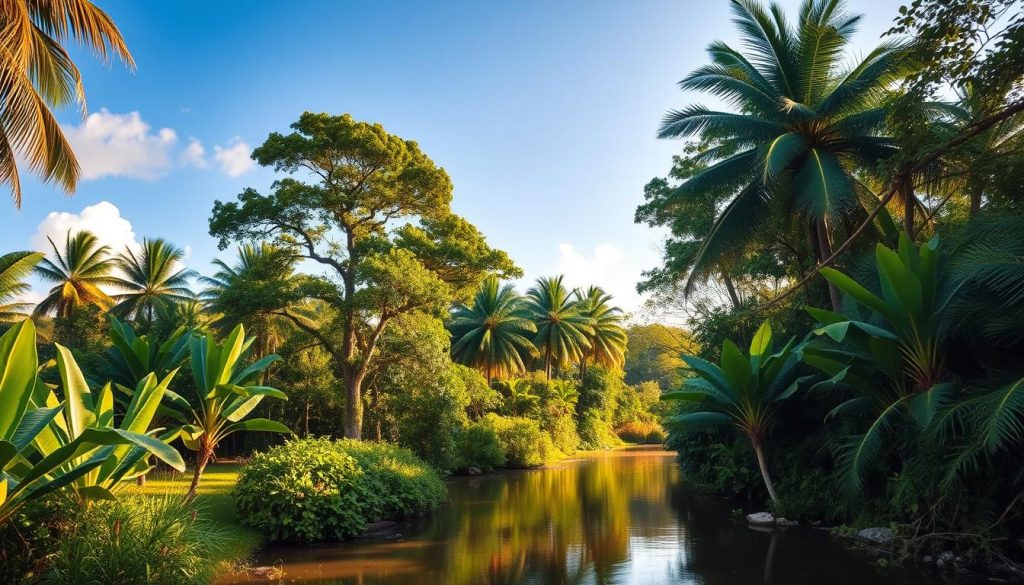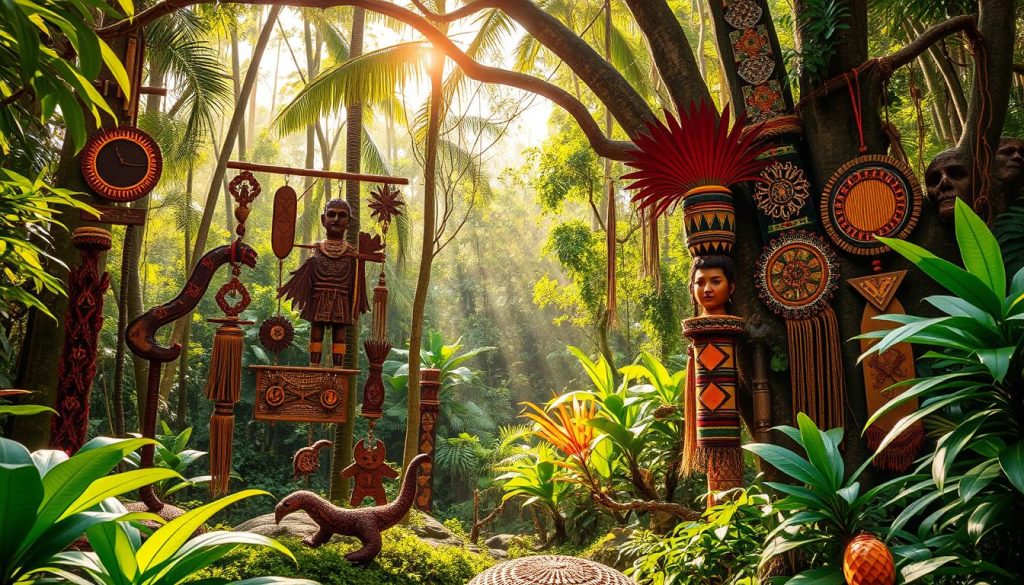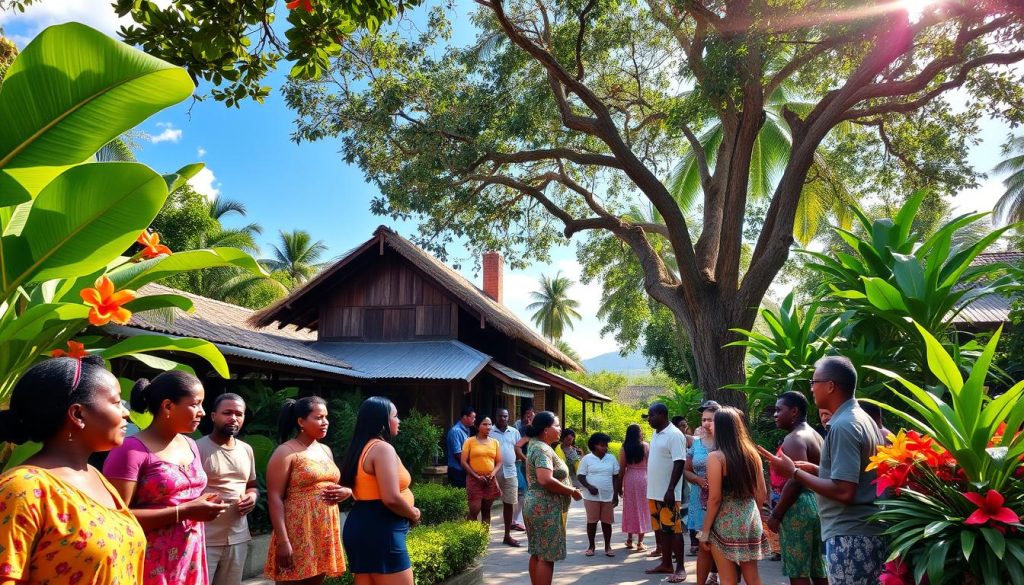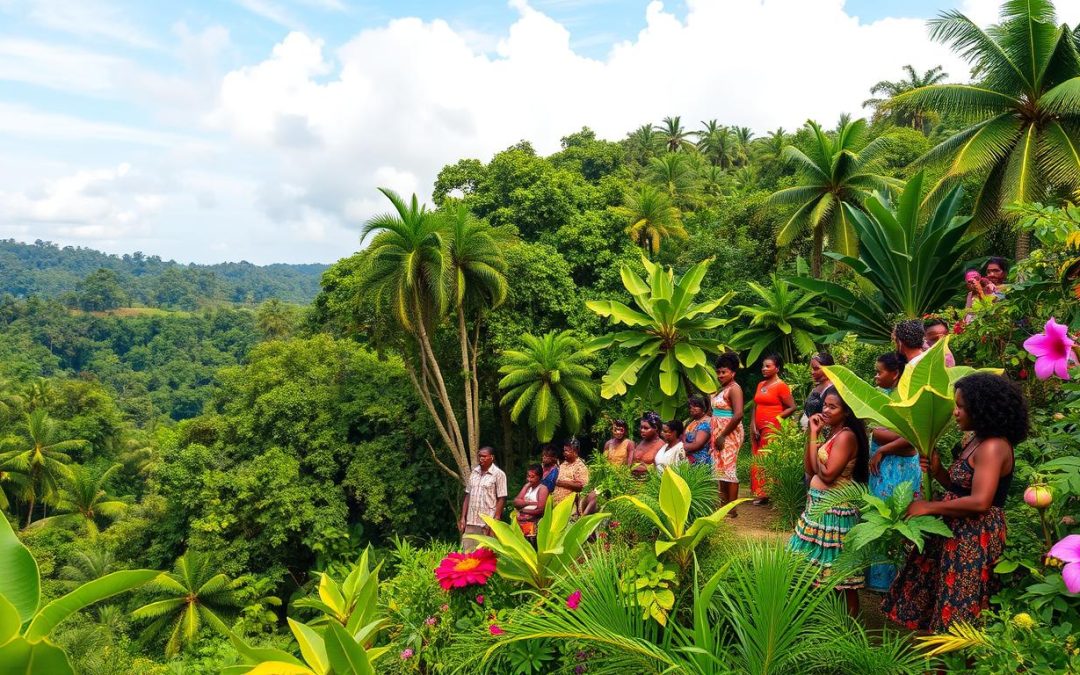Have you ever thought about how a small South American place can have so many languages? French Guiana, a part of France, has a special mix of languages. It shows how language and identity are connected.
French Guiana is on the northeastern coast of South America. It’s a place where French, Creole, and indigenous languages meet. About 75% of people speak French, showing the area’s rich language mix.
Exploring French Guiana’s languages, we see how different tongues live together. French is the official language, but Creole is more common. This shows how languages change over time.
Key Takeaways
- French is the official language, spoken by 75% of the population
- Creole serves as the predominant spoken language
- Over 25 regional language varieties exist
- Linguistic diversity stems from complex historical interactions
- The population speaks multiple languages reflecting cultural heritage
Language Overview in French Guiana
French Guiana is in the northeastern corner of South America. It has a unique mix of languages because of its diverse people and history. This French overseas department is a multilingual society.
Geographical Context
French Guiana covers 84,000 km². It’s known for its dense rainforests, which cover almost all of it. This environment greatly influences how people communicate and share cultures.
Population Distribution
As of January 2024, French Guiana has about 295,385 people. It has a very low population density of 3.5 people per square kilometer. The way people live affects the languages they speak:
- More than 50% of the population lives in Cayenne, the capital city
- Diverse ethnic groups add to the rich multilingual scene
- Urban areas use languages differently than rural ones
Linguistic Diversity Impact
The official language is French. But, the real richness comes from the many languages spoken. You’ll find indigenous Amerindian languages and Maroon Creole dialects. French Guiana is a colorful mix of communication styles.
“Language is the roadmap of a culture. It tells you where its people come from and where they are going.” – Rita Mae Brown
Exploring French Guiana’s languages shows how culture and language blend. Official French and local dialects create a special way of communicating.
Historical Evolution of Languages in French Guiana

French Guiana’s language history is rich and spans centuries. It starts with the indigenous languages of native Amerindian tribes. Seven main groups once lived in this area:
- Kalina
- Lokono (Arawak)
- Galibi
- Palikur
- Teko
- Wayampi
- Wayana
European colonization changed the language scene. The French tried to start a colony in the 16th century. This was when new languages came into play, making it a complex place.
“Languages are the roadmaps of a culture. They tell you where its people come from and where they have been.” – Rita Mae Brown
The French Guianese Creole developed from interactions between indigenous languages, European colonizers, and enslaved people. The Portuguese also had an impact, adding unique words.
| Language Group | Speakers | Historical Significance |
|---|---|---|
| Indigenous Languages | Approximately 8,000-10,000 | Original inhabitants’ communication |
| French Guianese Creole | 134,000 | Cultural bridge between communities |
| French | Dominant official language | Administrative and educational use |
Keeping indigenous languages alive is key to French Guiana’s culture. Even with colonial pressures, these languages are still important. They help keep community identity and traditional knowledge alive.
French as the Official Language
In French Guiana, French is a key part of culture and government. It is the official language, playing a big role in society and institutions.
Government Administration Usage
French is the main language for government work. It’s used in local and regional offices, official papers, public services, and legal actions.
- All official documents are written in French
- Government meetings and proceedings use French
- Public announcements and communications occur in French
Educational System Implementation
Schools in French Guiana focus on French. It’s the main language taught, helping students learn well.
- French is the main language of classroom instruction
- Curriculum materials are developed in French
- Standardized testing occurs in French
Media and Communication
Media in French Guiana mostly uses French. Newspapers, radio, and TV broadcasts are in French, showing its cultural value.
“French connects our diverse community, bridging different cultural backgrounds.”
Even though other languages exist, French is the main language. It helps everyone communicate and keeps things organized.
French Guiana: Official and widely spoken languages
French Guiana is known for its rich cultural mix. Being a part of France, it has a unique mix of languages. French is the main language used in government, schools, and media.

- French (official language)
- French Guianese Creole
- Amerindian languages
- Maroon Creole languages
- Immigrant languages
Linguistic diversity in French Guiana is more than just talking. It’s a way for different cultures to connect.
“Language is the road map of a culture. It tells you where its people come from and where they are going.” – Rita Mae Brown
| Language Category | Percentage of Speakers | Cultural Significance |
|---|---|---|
| French | 90% | Official administrative language |
| Creole | 60% | Cultural communication |
| Amerindian Languages | 10% | Indigenous heritage preservation |
Understanding French Guiana’s languages shows a lively place. Here, languages are not just for talking but also for showing who we are. French Guiana’s mix of languages makes it a special place.
French Guianese Creole: The Bridge Between Cultures
French Guiana’s language scene is full of vibrant Creole languages. These languages tell a story of cultural mix and strength. They are more than just a way to talk; they are stories of history and survival.
Development and Origins
French Guianese Creole came from a mix of colonial history. It was shaped by French colonizers, African slaves, and Indigenous people. This language was a practical way for them to communicate.
- Originated during the colonial plantation era
- Blends French lexical structures with African grammatical influences
- Reflects the multicultural heritage of French Guiana
Contemporary Usage
Today, Creole languages are key for communication in diverse groups. In cities like Cayenne and Matoury, you’ll hear French Guianese Creole everywhere. It’s used in markets, homes, and social events.
| Location | Creole Language Prevalence |
|---|---|
| Cayenne | High usage in daily communication |
| Rural Areas | Primary spoken language for many communities |
| Urban Centers | Coexists with standard French |
Cultural Significance
These Creole languages are living museums of cultural memory. They keep alive the history, resistance, and spirit of adaptation of French Guiana’s people.
“Language is the roadmap of a culture. It tells you where its people come from and where they are going.” – Rita Mae Brown
By celebrating Creole languages, French Guiana honors its unique identity. It shows the strength and creativity of its culture.
Indigenous Amerindian Languages

French Guiana is home to a rich mix of indigenous languages. These languages are more than just a way to talk. They hold traditional knowledge and identity.
Six distinct Amerindian languages thrive in this diverse territory:
- Wayana
- Emerillon
- Palijur
- Arawak
- Wayampi
- Kali’na
Exploring these languages shows a unique linguistic world. Each one has its own special traits, passed down through generations. With about 20,000 Indigenous people in French Guiana, these languages are more than words. They are entire worldviews.
Language is the roadmap of a culture. It tells you where its people come from and where they are going. — Rita Mae Brown
About 2% of French Guiana’s people speak an indigenous language. Saving these languages is key. It helps younger generations connect with their roots.
The Wayana language has around 1,200 speakers. The Teko language has fewer than 500. These numbers show how important it is to save these languages.
Maroon Creole Languages and Their Heritage
Explore the world of Maroon Creole languages in French Guiana. This place is full of cultural heritage and history. These languages are more than just a way to talk. They show the strength and will to survive.
Historical Background of Maroon Communities
Maroon Creole languages came from amazing stories. They were made by people who escaped slavery. These communities grew in the rainforests of French Guiana, creating their own languages.
These languages helped keep their culture alive. They were a way to resist and fight for their rights.
- Emerged from slave escape routes
- Developed complex communication systems
- Preserved cultural identity through language
Current Speaking Communities
Now, about 20,000 Maroons live in French Guiana. They keep their language alive. There are four main Creole languages in the area:
| Language | Speaker Population | Cultural Region |
|---|---|---|
| Aluku | 4,500 | Inland French Guiana |
| Saramaka | 5,000 | Border regions |
| Ndyuka | 6,500 | Eastern territories |
| Paramaccan | 4,000 | Southwestern areas |
Cultural Preservation Efforts
Keeping their language alive is very important to Maroons. Schools and community groups work hard to save these Creole languages. They want to make sure the next generation can speak them too.
Our language is more than words – it’s the heartbeat of our culture and the memory of our ancestors.
About 70% of Maroons also speak French. This shows they can adapt while still keeping their unique culture alive.
Foreign Language Influence and Usage
French Guiana is a vibrant example of a multilingual society. Here, linguistic diversity weaves a rich cultural tapestry. The territory’s unique location and complex history have created a special linguistic landscape.

In this place, you’ll find a remarkable ecosystem of languages. These languages show the territory’s rich history and immigration patterns:
- English is a key language for communication
- Portuguese connects to Brazilian culture
- Spanish shows ties to Latin America
- Haitian Creole reflects Caribbean migration
- Hakka adds Asian linguistic influences
Linguistic diversity in French Guiana is more than just talking. These languages are living parts of culture, linking communities and keeping history alive. About 30% of the people are immigrants, making the place multilingual and vibrant.
“Language is the road map of a culture. It tells you where its people come from and where they are going.” – Rita Mae Brown
Studies show that 10-20% of people speak languages other than French. This shows French Guiana’s ability to adapt linguistically. The language mix keeps changing, showing the territory’s cultural growth and global ties.
Language Education and Policy
The language education in French Guiana is complex. French is the official language. The system tries to keep linguistic diversity while meeting national standards.
Educational System Structure
French is the main language taught in schools. The system faces challenges because of the area’s many languages. Key points include:
- French is the main teaching language
- Trying to add regional languages to lessons
- Support for learning in many languages
Language Preservation Programs
French Guiana values its cultural heritage. It has special programs to save and share languages. The Langues et Cultures Régionales (LCR) program started in the 1980s. It works to keep and celebrate indigenous and Creole languages in schools.
“Language is the roadmap of a culture. It tells you where its people come from and where they are going.” – Rita Mae Brown
Government Initiatives
The local government has made plans to include more languages. These plans aim to:
- Accept and celebrate different languages
- Help those who speak minority languages
- Make schools welcoming to everyone
French Guiana is trying to find a balance. It wants to follow official language rules and honor its cultural languages.
Conclusion
Your journey through French Guiana’s languages shows a story of cultural strength and variety. These languages are more than ways to talk; they are stories of history, migration, and cultural mix. They have shaped this special South American place.
The languages of French Guiana show how they change through social interactions. From the French Creole of colonial times to the indigenous languages still alive, each one tells a story of survival. The mix of languages in French Guiana shows the complex culture of the region.
Learning about these languages helps us see why keeping them alive is important. Efforts to document and protect these languages show a dedication to keeping cultural memories alive. This is crucial as the way we communicate changes.
Your look into French Guiana’s languages shows that languages are more than just a way to talk. They are a living part of human experience. In French Guiana, every word spoken is filled with history, resistance, and pride. It shows the power of language to connect and enlighten us.
The above is subject to change.
Check back often to TRAVEL.COM for the latest travel tips and deals.
Here are some Tours & Sightseeing suggestions that might pique your interests!
